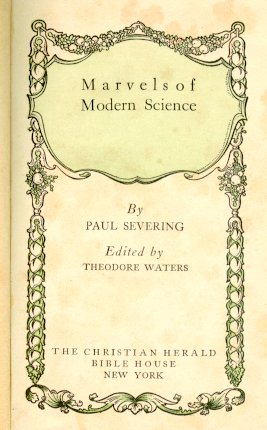Adding it Up in 1910
Today, a world prepares to be transformed. The University of Houston's College of Engineering presents this series about the machines that make our civilization run, and the people whose ingenuity created them.
Which age in human history saw the greatest change in daily life? Twelfth-century windmills, Gothic architecture, and a belief in invention changed that age beyond recognition. Mid-14th-century plagues changed the world by killing off half its population. Eighteenth-century revolution certainly changed the way we lived.
But for technological change, what can match those years before the First World War? My father, born in 1893, entered a world without airplanes, movies, or radio. Telephones, automobiles, X-rays, refrigeration, the germ theory of disease, and electric lights all existed. But they were still unknown to most people.
Here's a 1910 book, Marvels of Modern Science. The chapter titles tell of a world being turned on its ear: Flying Machines, Wireless Telegraphy, Radium, Moving Pictures, Sky-Scrapers. The last title asks, Can We Communicate with Other Worlds?
The authors thought airplanes were destined to become war machines. Radio signals had reached halfway around the world, but no one saw that radio would become an entertainment medium. Radium was the most murderously radioactive material known. A fifty-milligram particle cost $4000 (about 50,000 dollars in today's economy). A scientist could rent that particle for $200 per day.
The promise of movies was enormous. Edison had just cooked up crude means for synchronizing recordings with the moving images. It'd be two more decades before talkies appeared in theaters. But no one doubted that was where we were headed. The authors worried about keeping movies morally uplifting. They looked for the day when "remote hamlets" could see and hear Caruso singing opera.
A lyrical chapter on Ocean Palaces talks about the new ocean liners, Mauretania and Lusitania, which could now cross the Atlantic in just four days. (A German U-boat sank Lusitania five years later.) The White Star Company was just building two even larger ships: Olympic and Titanic. Since they were meant to carry huge payloads, the authors didn't look for new speed records. Two years later, Titanic hit an iceberg, trying to beat time to New York. Then it had too few lifeboats for all its paying passengers.
As we read, we compare the book with the way the 20th century really did unfold. But the last chapter hasn't unfolded yet. Will we ever communicate with other worlds? The authors doubt it. It was clear that other life-bearing stars would be light-years away, and only Mars could conceivably sustain life in our solar system.
If there were life, the only communication the authors imagine is by signaling. They rightly decide that viewing signal flags through telescopes would be impractical even for neighboring Mars. They wrongly conclude that even Mars is beyond the reach of radio.
But the odd part about this view from 1910 is that what really did happen isn't mentioned. The idea of space flight -- of actually going there -- didn't cross the authors' minds, back in 1910.
I'm John Lienhard, at the University of Houston, where we're interested in the way inventive minds work.
(Theme music)
Severing, P., Marvels of Modern Science. (Edited by Theodore Waters), New York: the Christian Herald Bible House, 1910.
